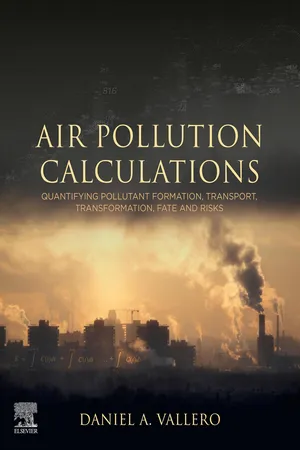
Air Pollution Calculations
Quantifying Pollutant Formation, Transport, Transformation, Fate and Risks
- 568 pages
- English
- ePUB (mobile friendly)
- Available on iOS & Android
Air Pollution Calculations
Quantifying Pollutant Formation, Transport, Transformation, Fate and Risks
About this book
Air Pollution Calculations introduces the equations and formulae that are most important to air pollution, but goes a step further. Most texts lack examples of how these equations and formulae apply to the quantification of real-world scenarios and conditions. The ample example calculations apply to current air quality problems, including emission inventories, risk estimations, biogeochemical cycling assessments, and efficiencies in air pollution control technologies. In addition, the book explains thermodynamics and fluid dynamics in step-by-step and understandable calculations using air quality and multimedia modeling, reliability engineering and engineering economics using practical examples likely to be encountered by scientists, engineers, managers and decision makers. The book touches on the environmental variables, constraints and drivers that can influence pollutant mass, volume and concentrations, which in turn determine toxicity and adverse outcomes caused by air pollution. How the pollutants form, move, partition, transform and find their fate are explained using the entire range of atmospheric phenomena. The control, prevention and mitigation of air pollution are explained based on physical, chemical and biological principles which is crucial to science-based policy and decision-making.Users will find this to be a comprehensive, single resource that will help them understand air pollution, quantify existing data, and help those whose work is impacted by air pollution.- Explains air pollution in a comprehensive manner, enabling readers to understand how to measure and assess risks to human populations and ecosystems actually or potentially exposed to air pollutants- Covers air pollution from a multivariate, systems approach, bringing in atmospheric processes, health impacts, environmental impacts, controls and prevention- Facilitates an understanding of broad factors, like climate and transport, that influence patterns and change in pollutant concentrations, both spatially and over time
Frequently asked questions
- Essential is ideal for learners and professionals who enjoy exploring a wide range of subjects. Access the Essential Library with 800,000+ trusted titles and best-sellers across business, personal growth, and the humanities. Includes unlimited reading time and Standard Read Aloud voice.
- Complete: Perfect for advanced learners and researchers needing full, unrestricted access. Unlock 1.4M+ books across hundreds of subjects, including academic and specialized titles. The Complete Plan also includes advanced features like Premium Read Aloud and Research Assistant.
Please note we cannot support devices running on iOS 13 and Android 7 or earlier. Learn more about using the app.
Information
Table of contents
- Cover image
- Title page
- Table of Contents
- Copyright
- Dedication
- Preface
- Chapter 1: Introduction
- Chapter 2: Characterizing air pollutants
- Chapter 3: Pollutant transformation
- Chapter 4: Environmental partitioning
- Chapter 5: Air partitioning
- Chapter 6: Physical transport of air pollutants
- Chapter 7: Water and the atmosphere
- Chapter 8: Air pollution biogeochemistry
- Chapter 9: Thermal reactions
- Chapter 10: Air pollution phases and flows
- Chapter 11: Sampling and analysis
- Chapter 12: Air pollution risk calculations
- Chapter 13: Air pollution control technologies
- Chapter 14: Air pollution dispersion models
- Chapter 15: Economics and project management
- Chapter 16: Reliability and failure
- Chapter 17: Air pollution decision-making
- Appendix 1: Key equations
- Appendix 2: Abbreviations and symbols
- Index